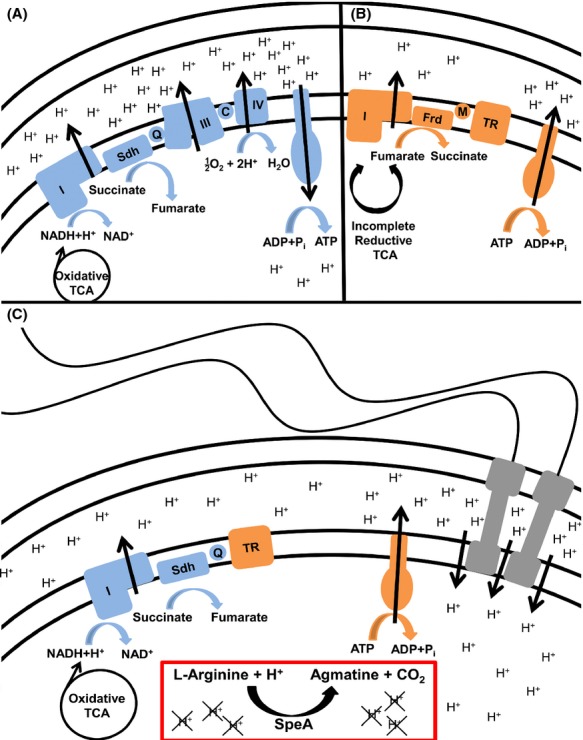Figure 7.

Model of μH+ generation and maintenance during swarming. Mechanisms for generating and maintaining μH+ are diagramed for aerobic conditions (A, blue), anaerobic conditions (B, orange), and the unusual system used during Proteus mirabilis swarming (C). (A) Under aerobic conditions, NADH is generated from pyruvate through a complete oxidative TCA cycle. Protons are pumped via a respiratory chain composed of NADH dehydrogenase (I), succinate dehydrogenase (Sdh), ubiquinone (Q), the cytochrome bc complex (III), cytochrome c (C), and cytochrome c oxidase (IV). A large proton gradient (ΔpH) is established and can be used to generate ATP. (B) When oxygen is not available, a branched TCA cycle is used and NADH will not be produced. The P. mirabilis anaerobic respiratory chain is likely composed of an alternative dehydrogenase (I), fumarate dehydrogenase (Frd), menaquinone (M), and a terminal reductase (TR). μH+ can be maintained by hydrolyzing the ATP produced through fermentation to pump protons across the membrane. This process is less energetically favorable and produces a weak ΔpH and μH+. (C) During swarming, P. mirabilis operates a complete oxidative TCA cycle and generates NADH, but oxygen is not used as the terminal electron acceptor. The swarming respiratory chain appears to be composed of NADH dehydrogenase (I), succinate dehydrogenase (Sdh), ubiquinone (Q), and an unknown terminal reductase (TR), possibly fumarate. ATP is most likely hydrolyzed to pump protons as the ATPase would otherwise be competing with the numerous flagella for ΔpH. While this process produces a weaker pH gradient than aerobic respiration, arginine and SpeA can be utilized as one method for consuming intracellular protons to strengthen the ΔpH and μH+ while also producing agmatine that can be utilized for putrescine biosynthesis.
